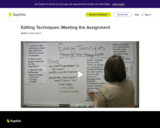In Module 4, students learn about the internment of Japanese Americans during World War II. They study the experiences of survivors of internment, focusing most centrally on the experiences conveyed in the anchor text, Farewell to Manzanar. This memoir, told through the eyes of Jeanne Wakatsuki Houston, chronicles the experiences of her and her family at the Japanese American internment camp Manzanar. Through close examination of this text and of other supplemental texts that provide context about the impact of internment, students deepen their understanding of this dark time in history and of the lessons that can be learned from it.
In Unit 1, students are introduced to the anchor text. They analyze how the text makes connections among and distinctions between important individuals, ideas, or events, tracking these connections and distinctions in a note-catcher. They also begin to develop an anchor chart to highlight significant ideas that emerge from the text, including the ways in which Jeanne and her family members are impacted by internment. To further develop the background knowledge needed to interpret the events described in the text, students examine images and primary source documents that center on other Japanese American internment experiences. Also in Unit 1, students watch two segments of the Farewell to Manzanar film. They focus on key moments, noting the extent to which the film stays faithful to or departs from the text. Students also examine how significant ideas from the text are conveyed in the film. The assessments of the unit evaluate students’ abilities (a) to analyze the connections and distinctions made in a new chapter of the text and (b) to discuss the causes and impacts of Japanese American internment in a collaborative discussion.
In the first half of Unit 2, students finish reading the anchor text and watch the two final segments of the Farewell to Manzanar film. They continue analyzing connections and distinctions, identifying significant ideas, and evaluating the film’s depiction of events in the text. They also analyze the points of view of different individuals in the text. The Mid-Unit 2 Assessment challenges students to demonstrate these analytical skills with a new chapter of the text. In the second half of Unit 2, students revisit the Painted Essay® structure to analyze a model literary argument essay that addresses the following prompt: One significant idea in the text Farewell to Manzanar is that Jeanne’s youth impacts her understanding of events in the text. How effectively does the film Farewell to Manzanar convey this significant idea? Using a similar prompt about the significant idea that Papa feels conflicted loyalties to both the United States and Japan, students write collaborative argument essays that prepare them to produce their own independent argument essays during the end of unit assessment. These essays work with the same question but invite students to choose a different significant idea on which to focus.
In the first half of Unit 3, students engage with supplemental texts that help them better understand the impact and legacy of internment. First, students read about the efforts of some Japanese Americans to seek redress, or reparations, for their incarceration. Then, they read about the negative psychological effects of internment and about the protests of internment survivors against modern-day migrant detention centers. With these supplemental texts as well as the anchor text in mind, students develop a list of “lessons from internment”: enduring understandings that can be taken away from the study of Japanese American internment. For the Mid-Unit 3 Assessment, students collaboratively discuss these lessons from internment and how they are embodied by the redress movement. In the second half of Unit 3, students apply this learning to their own communities. They conduct research about and then interviews with activist organizations whose work embodies, in some way, these lessons of internment. Students present their findings during the End of Unit 3 Assessment.
For their performance task, students participate in small group discussions during the “Activist Assembly.” With classmates and members of the local community, students discuss the best ways to apply lessons from internment to their own communities, using evidence from their research of local organizations to support their ideas.


